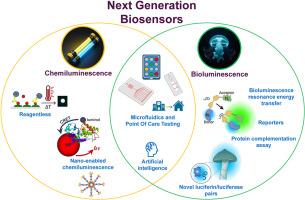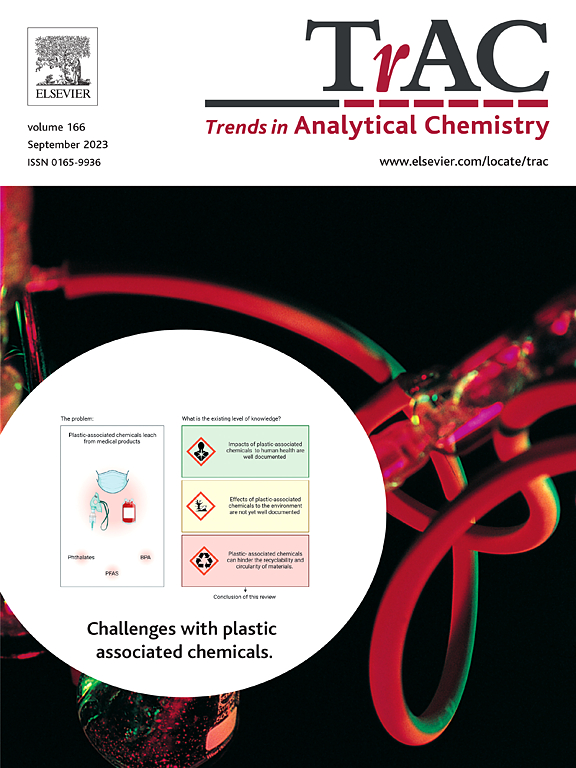照亮生物传感器:使能技术中的化学发光和生物发光
IF 11.8
1区 化学
Q1 CHEMISTRY, ANALYTICAL
引用次数: 0
摘要
化学发光(CL)和生物发光(BL)都是一种迷人的自然现象,通过化学反应发光,无需激发光源。化学发光和生物发光已被广泛用于研究和技术开发,并已成为从化学到医学等领域的重要工具。具体来说,它们在设计生物传感器的高灵敏度和特异性检测探针方面具有独特的优势。在 CL 领域,新颖的探针设计、纳米材料的集成以及合成策略提高了生物传感器应用的灵敏度、选择性和多功能性。这与便携式微流体技术相结合,促进了对生物分子、代谢物、病原体和环境污染物的高精度、低成本检测和定量。同样,对生物发光蛋白的探索也促成了基因编码生物发光探针的工程化,使生物传感器、分子诊断方法以及活体系统内实时成像和检测成为可能。此外,生物发光报告分析和生物传感器的开发已在高通量筛选、药物发现和生物机理研究中得到应用。将 BL 和 CL 技术集成到护理点设备中,已在医疗诊断、环境监测和食品安全中得到应用。本综述重点介绍 CL 和 BL 技术的最新进展,主要侧重于它们对生物传感器开发的影响。本文章由计算机程序翻译,如有差异,请以英文原文为准。

Shining light on biosensors: Chemiluminescence and bioluminescence in enabling technologies
Chemiluminescence (CL) and bioluminescence (BL) are both fascinating natural phenomena involving the emission of light by a chemical reaction without the need for an excitation source. Both CL and BL have been used extensively in research and technology development and have become valuable tools in fields ranging from chemistry to medicine and beyond. Specifically, they offer unique advantages in the design of highly sensitive and specific detection probes for biosensors. In the CL field, novel probe designs, integration of nanomaterials, and synthetic strategies have led to enhanced sensitivity, selectivity, and versatility in biosensor applications. This in combination with portable microfluidic technologies has facilitated the detection and quantification of biomolecules, metabolites, pathogens, and environmental pollutants with high accuracy and low cost. Similarly, the exploration of bioluminescent proteins has led to the engineering of genetically encoded bioluminescent probes enabling the development of biosensors, molecular diagnostics methods, and real-time imaging and detection within living systems. Further, the development of bioluminescent reporter assays and biosensors has shown application in high-throughput screening, drug discovery, and biological mechanistic studies. The integration of BL and CL technologies into point-of-care devices has found applications in medical diagnostics, environmental monitoring, and food safety. This review highlights recent advancements in both CL and BL technologies, mainly focusing on their implications in biosensor development.
求助全文
通过发布文献求助,成功后即可免费获取论文全文。
去求助
来源期刊

Trends in Analytical Chemistry
化学-分析化学
CiteScore
20.00
自引率
4.60%
发文量
257
审稿时长
3.4 months
期刊介绍:
TrAC publishes succinct and critical overviews of recent advancements in analytical chemistry, designed to assist analytical chemists and other users of analytical techniques. These reviews offer excellent, up-to-date, and timely coverage of various topics within analytical chemistry. Encompassing areas such as analytical instrumentation, biomedical analysis, biomolecular analysis, biosensors, chemical analysis, chemometrics, clinical chemistry, drug discovery, environmental analysis and monitoring, food analysis, forensic science, laboratory automation, materials science, metabolomics, pesticide-residue analysis, pharmaceutical analysis, proteomics, surface science, and water analysis and monitoring, these critical reviews provide comprehensive insights for practitioners in the field.
 求助内容:
求助内容: 应助结果提醒方式:
应助结果提醒方式:


